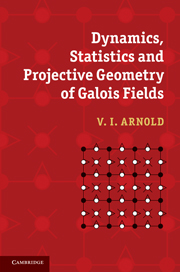Book contents
- Frontmatter
- Contents
- Preface
- 1 What is a Galois field?
- 2 The organisation and tabulation of Galois fields
- 3 Chaos and randomness in Galois field tables
- 4 Equipartition of geometric progressions along a finite one-dimensional torus
- 5 Adiabatic study of the distribution of geometric progressions of residues
- 6 Projective structures generated by a Galois field
- 7 Projective structures: example calculations
- 8 Cubic field tables
- Index
3 - Chaos and randomness in Galois field tables
Published online by Cambridge University Press: 01 March 2011
- Frontmatter
- Contents
- Preface
- 1 What is a Galois field?
- 2 The organisation and tabulation of Galois fields
- 3 Chaos and randomness in Galois field tables
- 4 Equipartition of geometric progressions along a finite one-dimensional torus
- 5 Adiabatic study of the distribution of geometric progressions of residues
- 6 Projective structures generated by a Galois field
- 7 Projective structures: example calculations
- 8 Cubic field tables
- Index
Summary
Looking at the tables of Galois fields in the previous chapter, one has the impression that the ways of filling them by the integers from 1 to z − 1 (where z is the number of elements in the field, taken to be equal to p2 in our examples) behave in some random kind of way: it is difficult to guess the place of the next symbol k + 1 given the place of the preceding symbol k.
Attempts to formulate this empirical observation as a mathematical statement lead to hundreds of conjectures. Perhaps most of these conjectures will become interesting theorems in the future: at present, only a few of them have been proved.
I will now describe the general scheme for formulating the ‘randomness’ conjectures.
To begin with, note that genuinely random fillings have several properties known from the theory of probability and stochastic processes.
To check the ‘randomness’ of the field table filling, choose one of these properties and check whether the ‘quasi-random numbers’ that fill the table do approximately satisfy it.
Arguing in this way, we arrive at a conjecture that claims that the chosen randomness property is approximately fulfilled by the matrix of the field of z = pn elements, and that the approximation gets better and better as we increase the prime number p for fixed n, i.e. the number z of elements. In the limit p → ∞, the property is conjectured to be fulfilled exactly.
- Type
- Chapter
- Information
- Publisher: Cambridge University PressPrint publication year: 2010



